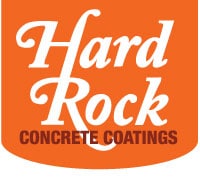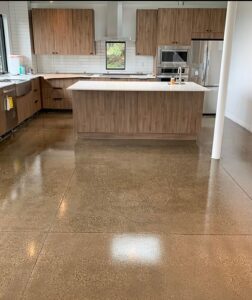Decorative concrete can transform an indoor room and give it a unique, modern look, but it’s vital to apply a sealer to your concrete floor because it prolongs the concrete’s life and is the final layer of protection. It also enhances and preserves the appearance, so doing it right is essential. Today’s blog will discuss what a concrete sealer does and the process of doing it.
What a Concrete Sealer Does
As mentioned above, a concrete sealer protects your flooring and gives it a polished look. It also brings out the beauty of the concrete by enhancing its color and adds sheen. Sealing preserves the decorative treatment by protecting the floor surface from abrasions and stains, with some floor sealers forming a protective coating on the surface of the concrete while others penetrate the floor.
Steps to Sealing Indoor Concrete Floor
It’s usually a good idea to have a professional seal concrete flooring; however, if you are thinking about DIY, here are the ten steps to doing it.
- Allow recently applied concrete to cure fully.
- Thoroughly let stains and overlays dry before sealing.
- Cover baseboards for protection or remove them.
- Clean the concrete floor and allow it to dry.
- Put on protective gear and clothing.
- Properly ventilate the area by opening windows or doors.
- Apply a thin coat of concrete floor sealer and let it dry.
- In the other direction, apply a second coat and let that dry.
- Wax the surface of the floor to prolong the sealer’s longevity.
- Reapply the sacrificial wax as it wears off.
It’s important to maintain the sealer by reapplying it every few years.
Best Concrete Sealers
The best and most common interior concrete sealers include the film-forming ones you apply to the surface of the concrete. They are used most often for interior decorative concrete work. There are several types of sealers, though to consider. Acrylics form a thin protective coating on the surface of the concrete and are available in both solvent and water-based formulations. Polyurethanes form a high-build protective film on the concrete surface and are best on high-traffic flooring; this provides good resistance to scuffs and staining. It also enhances the beauty of either colores, stamped, or exposed-aggregate concrete countertops.
Epoxies also form a high-build concrete coating and are two-compound products mixed before application. They work well on high-traffic areas like cement-based overlays. It’s available in clear or pigmented if you wish to add color. These products protect against yellowing and are usually transparent.
Want a Professional Look?
A trained and experienced concrete professional like we have at Hard Rock Concrete Coatings can ensure a sealer is applied right. We specialize in acid staining, epoxy coating, and concrete repair. Located in Riverton, Utah, our experts can offer you a free quote and create something beautiful and unique. Contact us, and we’ll get back to you as soon as possible.



